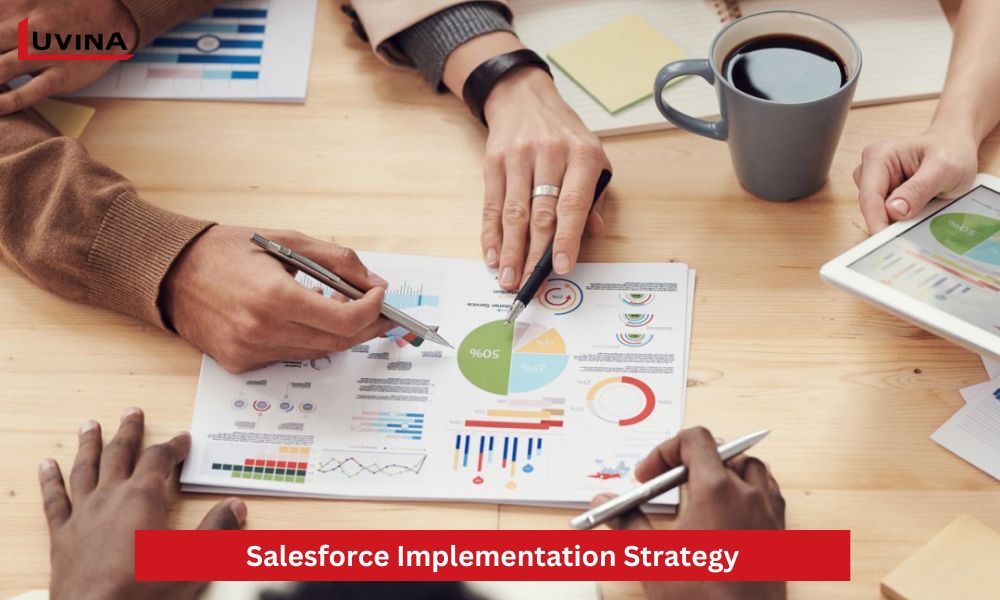Salesforce is one of the most powerful CRM tools, helping businesses increase sales efficiency. The Salesforce implementation process can be quite complex, with failure rates ranging from 30% to 70%. However, businesses can still successfully implement Salesforce.
In this article, let’s explore how to develop a Salesforce implementation strategy, detailed deployment steps, and important information about Salesforce implementation costs. Understanding these details will greatly impact the success of your CRM deployment project.
What is Salesforce Implementation?
Today, every business aims to deepen its connection with customers and build brand image by fostering loyal customers, and Salesforce can help businesses achieve that.
Salesforce is a powerful CRM tool. This platform integrates the three most popular CRM products: operations, analytics, and collaboration.
Salesforce sales cloud implementation is deploying a CRM system that centralizes all business activities and primary communications. Successfully deploying this platform can bring significant benefits to a business. Not only does it help optimize operational processes, but Salesforce also facilitates smoother collaboration among departments and teams. Furthermore, Salesforce provides businesses with a comprehensive view of their customers.
8 Salesforce Implementation Steps

Salesforce implementation can indeed be a complex process, but it can still be successful with a clear strategy and a detailed, reasonable implementation plan. Typically, Salesforce implementation steps involve:
Step 1 – Define goals and establish relevant KPIs
This is the first step in the deployment process of any platform, tool, or software. This step involves setting business objectives, analyzing customer needs, and conducting market research.
To easily identify what the business needs from a new CRM tool, you need a list of tasks, and workflows for each department. These pieces of information will serve as a basis for defining KPIs and help deployment partners understand the business needs when implementing Salesforce CRM.
Step 2 – Budget planning
Salesforce implementation costs can vary widely. The specific Salesforce implementation strategy will depend entirely on the budget. The overall budget for a CRM deployment project will include various types of expenses, such as licenses, implementation consulting fees, data migration fees, integration fees, training fees, support and maintenance fees, etc.
Step 3 – Find a suitable implementation partner
To successfully implement Salesforce, you need to find experts with relevant expertise. Consider partnering with experienced consultants who have implemented for organizations of similar scale within your industry.
Ranked as one of the top Salesforce development companies in Vietnam by Clutch, Luvina provides CRM solutions to enhance customer interactions, streamline sales processes, and drive growth for businesses. Based on your business requirements, Luvina designs tailored solutions precisely aligned with those needs.
Luvina has experience collaborating with businesses across various sectors, such as finance, banking, insurance, manufacturing, human resources, etc. Our team is proficient in working in English, Vietnamese, and Japanese and is ready to provide 24/7 support regardless of time zones.

With two outsourcing models, project-based and offshore development centers, Luvina offers flexible options to leverage over 750+ skilled IT professionals effectively.
Contact Luvina today to kickstart your Salesforce implementation project.
Get in touch now
to get a free consultant from us
Step 4. Develop a change management strategy
The change management strategy ensures your employees have everything they need to adapt to the new system. Therefore, it’s a crucial step contributing to the success of the Salesforce Cales cloud implementation
project.
To develop a change management strategy, conduct surveys to gather feedback from employees during the change process. Ensure these surveys are anonymous to receive the most honest feedback. The change management strategy will serve as the foundation for developing the Salesforce implementation strategy and communication plan.
Step 5. Data Migration for CRM
Moving data from the old system to the new one is much more complex than you might think. This process also requires specialized knowledge and skills. Therefore, investing in a team with experience in data migration for organizations of similar scale is essential.
To ensure a smooth data migration process, you also need to develop a detailed plan, select the data carefully, and map out field mappings accurately.
>> Related Post: Salesforce Migration – Benefits, Considerations and Process
Step 6. Gradual feature rollout
Salesforce offers a plethora of useful features for businesses. However, too many features can make it challenging for employees to familiarize themselves with and utilize the platform effectively. Therefore, it’s essential to roll out features gradually to allow employees enough time to learn and adapt to the new tool.
Start by deploying features separately for each department. Then, monitor the feature deployment process, gather feedback regularly, and make timely adjustments before rolling out the next set of features.
Step 7. Develop an employee training program
Without proper and sufficient training, employees won’t know how to use Salesforce, thus not fully leveraging its potential, or even not using it at all. Therefore, to ensure employees easily adapt to the new system, continuously organize group training sessions and provide instructional videos post-training. Businesses can either plan and allocate staff for training internally or utilize the training services offered by Salesforce implementation partners.

Step 8. Maintenance and Support
The Salesforce implementation process is an ongoing one with many updates and changes. Therefore, you need to plan for continuous maintenance to promptly detect and address any issues, while also updating changes quickly to align with the business’s operations. Nowadays, most Salesforce implementation consulting companies offer maintenance services.
How to Plan Salesforce Implementation Strategy
Creating a sensible strategy before deploying Salesforce can help businesses overcome potential challenges, optimize resources, and ensure the long-term success of the project. Here are some Salesforce implementation best practices
- Choose the right project participants: Selecting the most suitable individuals for the project ensures consistency and fosters collaboration, driving a cohesive vision.
- Document and analyze business processes: Recording and analyzing business processes ensures seamless integration into the new system, facilitating a successful Salesforce CRM deployment.
- Define appropriate budget and timeline: Setting a budget and timeline for the project helps mitigate delays and ensure the project scope is met.
- Identify key success metrics: Key success metrics help track project progress, manage processes effectively, and determine project completion timelines.
- Select communication channels: Effective communication is crucial for a Salesforce implementation project. Therefore, choose unified communication channels among project participants.
- Identify end users: Identifying end users and understanding their needs helps adjust deployment plans effectively, ensuring user acceptance of the new system. Additionally, the number of end users also impacts Salesforce implementation costs.

3 Types of Salesforce CRM Implementation
Choosing the right type is crucial for the success of a Salesforce implementation project. Currently, there are 3 different types of implementing Salesforce CRM. Each type has its own pros and cons for businesses to choose from based on their needs.
1. In-house implementation
In-house implementation means a business deploys Salesforce by itself and takes full responsibility for the results. However, it’s very rare for a business to fully implement Salesforce on its own. Most businesses still require consulting support from a third party.
In-house implementation allows businesses to be more independent during the deployment process and reduce costs. However, this method often takes more time, incurs higher expenses, and carries the risk of errors. The features and tools that an in-house team can deploy are also quite limited.
2. Third-party implementation partners
In contrast to in-house implementation, when collaborating with third-party implementation partners, consulting partners handle most of the stages in the deployment process. Most companies providing Salesforce development services in the current market offer comprehensive services ranging from planning, implementation, training, maintenance, etc.
With the assistance of experts from third parties, your Salesforce implementation project will have a higher success rate, be deployed faster, and be more customizable. However, this deployment method also requires businesses to invest a considerable amount of money.

3. Hybrid implementation
This is a mixed approach to Salesforce CRM implementation between the two mentioned above, where the business shares responsibility with the consulting partner. This method is very suitable for confident businesses capable of handling some stages in the deployment process.
The biggest advantage of this deployment method is its flexibility. Having company employees involved in the deployment process also helps the business build a team capable of handling maintenance issues post-deployment. Additionally, hybrid implementation also helps reduce Salesforce implementation cost.
Salesforce Implementation Cost
On average, the cost of Salesforce implementation ranges from $5,000 to over $100,000. It’s challenging to determine the exact cost of a Salesforce project because the overall cost depends on many factors, such as project scope, number of licenses, user count, service fees, etc.
The features of the tool also have a significant impact on the overall project cost. To save costs, you need to plan the deployment carefully and prioritize the most important features to integrate.

Conclusion
Implementing CRM is a complex process that requires a detailed plan and meticulous, precise execution. We hope this article has provided you with a general overview of implementing Salesforce CRM with basic steps. With the information in this article, we believe you have the necessary conditions for successful Salesforce implementation.
To learn more about Salesforce solutions, check out these additional resources:
>> 7 Important Tips for Custom Salesforce Development
>> Benefits And Features Of Salesforce
>> Empower Your Business With Salesforce App Development Service









Read More From Us?
Sign up for our newsletter
Read More From Us?
Sign up for our newsletter